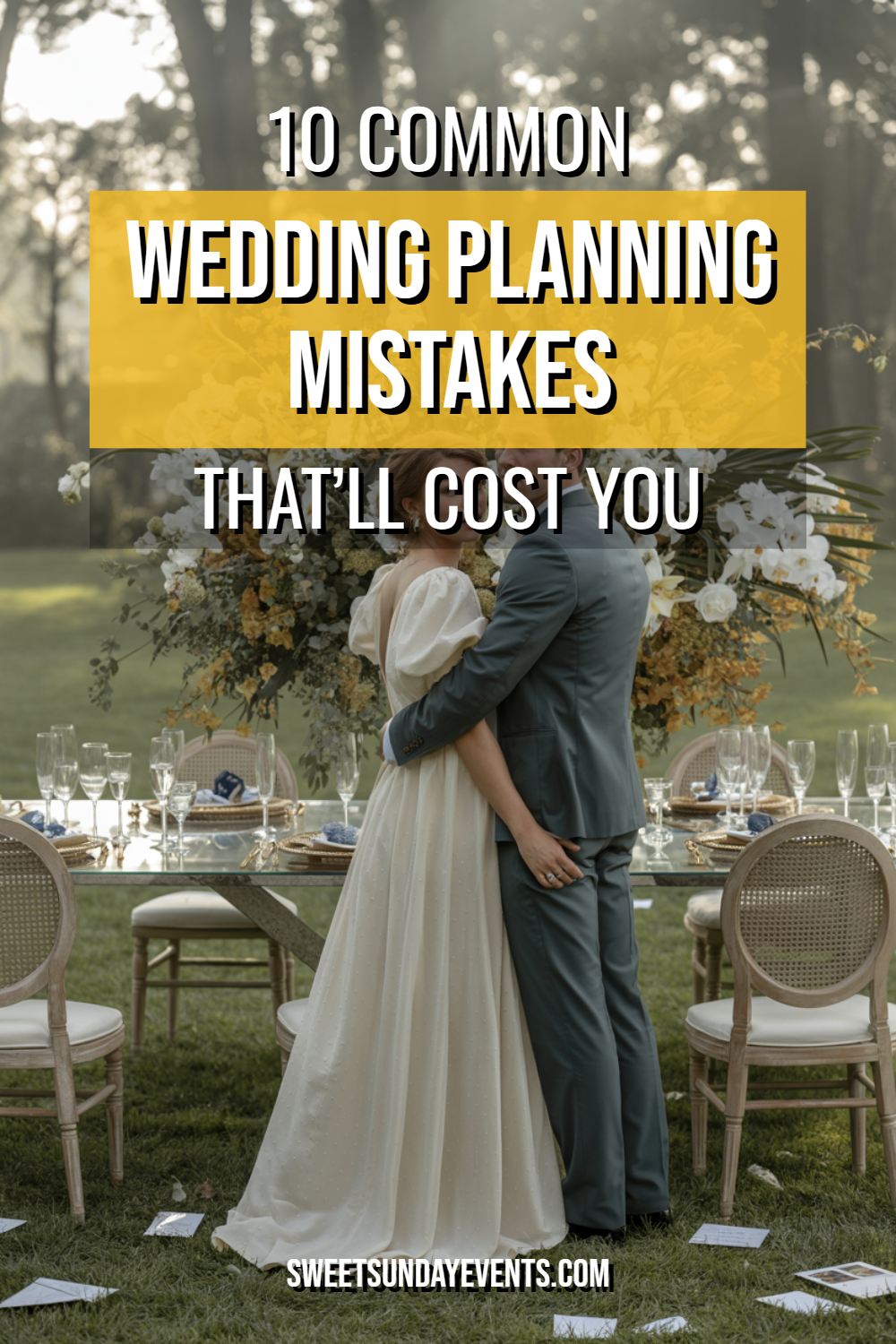After witnessing countless couples navigate the treacherous waters of wedding planning, I’ve seen the same costly mistakes happen over and over again.
These aren’t just minor hiccups—they’re budget-busting, stress-inducing blunders that can turn your dream day into a financial nightmare.
Let’s dive into the ten most expensive wedding planning mistakes and how to avoid them.
1. Booking Your Venue Without Reading the Fine Print
The contract seemed straightforward when you signed it, but now you’re discovering hidden fees that weren’t mentioned during your initial tour. Venue contracts are notorious for their sneaky additional charges that can inflate your budget by thousands.
Service charges, overtime fees, and mandatory vendor restrictions are just the beginning. Many venues charge extra for basic necessities like tables, chairs, or even electricity usage beyond a certain threshold.
Hidden Costs That Blindside Couples
Setup and breakdown fees can range from $500 to $2,000, depending on your venue’s policies. Some locations charge separately for ceremony and reception spaces, even when they’re advertised as “package deals.”
Parking fees, security deposits, and damage waivers often appear as line items you never saw coming. These charges can easily add $1,000 to $3,000 to your final bill.
How to Protect Yourself
Ask for a detailed breakdown of all potential charges before signing anything. Request to see contracts from previous events to understand what additional fees typically arise.
Negotiate caps on certain charges and get everything in writing. A verbal agreement with your venue coordinator means nothing when the final invoice arrives.
2. Underestimating Catering Costs
Food costs extend far beyond the per-person plate charge you initially discussed with your caterer. Service staff, gratuities, taxes, and equipment rentals can double your expected catering budget.
That $75 per person quote suddenly becomes $150 when you factor in the 20% service charge, 8% tax, mandatory gratuity, and rental fees for linens, glassware, and serving equipment.
The Real Cost Breakdown
| Base Cost | Additional Fees | Total Cost |
|---|---|---|
| $75/person | Service charge (20%) | $90/person |
| Tax (8%) | $97/person | |
| Gratuity (18%) | $115/person | |
| Equipment rental | $125/person | |
| Cake cutting fee | $130/person |
Late-night snacks, cocktail hour appetizers, and vendor meals add another layer of expense. Don’t forget about the bar package, which often comes with its own set of hidden charges.
Budgeting Realistically
Plan for catering costs to be 40-50% higher than the initial per-person quote. Factor in all service charges, taxes, and mandatory gratuities from the beginning.
Ask about vendor meal requirements and whether you need to provide food for your photographer, DJ, and other service providers. These meals can add $200-500 to your catering bill.
3. Changing Your Mind After Deposits Are Paid
Wedding planning involves dozens of decisions, and changing your mind after paying deposits can be devastatingly expensive. Vendors rarely offer full refunds, and some contracts include change fees that can cost hundreds or thousands of dollars.
Switching photographers three months before your wedding might mean losing your entire $2,000 deposit. Changing your floral arrangements after the initial consultation could trigger redesign fees and material costs.
The True Cost of Indecision
Florists often require 50% deposits and charge additional design fees for major changes. Photography and videography contracts typically include strict cancellation policies with minimal refund options.
Venue changes are the most expensive mistakes, often resulting in complete loss of deposits ranging from $1,000 to $10,000. Catering modifications can trigger restocking fees and menu redesign charges.
Making Decisions That Stick
Take time to thoroughly research vendors before signing contracts. Sleep on major decisions and discuss them with your partner before committing financially.
Create a detailed vision board and vendor comparison chart before meeting with potential providers. This preparation helps you make confident decisions the first time.
4. Ignoring the 20% Rule
Most wedding budgets fail because couples don’t account for the inevitable cost overruns that plague every wedding. The 20% rule suggests setting aside an additional 20% of your total budget for unexpected expenses and last-minute additions.
Wedding planning involves countless small decisions that seem insignificant individually but add up to substantial amounts. Upgraded linens, additional centerpieces, and extra invitations can easily consume an extra $2,000-5,000.
Where the Extra Costs Hide
Guest list changes often trigger cascading expenses across multiple vendors. Adding ten more guests affects catering, seating arrangements, invitations, and favors.
Weather contingencies for outdoor weddings can require tent rentals, heating, or venue changes. These emergency solutions often cost 50-100% more than planned alternatives.
Building Your Safety Net
Calculate your total wedding budget and automatically add 20% to that figure. Keep this money in a separate account designated specifically for wedding overruns.
Track every expense meticulously and review your budget monthly. Early awareness of cost overruns gives you time to make adjustments before they become financial disasters.
5. Booking Vendors Too Late
Popular vendors book up quickly, especially during peak wedding season. Waiting too long to secure your preferred vendors often means settling for more expensive alternatives or compromising on quality.
Prime Saturday dates in popular months get reserved 12-18 months in advance. Procrastinating on vendor selection can cost you thousands in premium pricing or force you to accept subpar service providers.
The Premium You’ll Pay
Last-minute vendor bookings often come with rush fees ranging from 10-25% of the total contract value. Available vendors may quote higher prices because they know you have limited options.
Quality vendors get booked early, leaving you with inexperienced providers who may deliver disappointing results. Poor vendor performance can ruin your wedding day and waste thousands of dollars.
Timing Your Vendor Search
Start researching vendors 12-15 months before your wedding date. Book your venue, photographer, and caterer first, as these are the most difficult to replace.
Create a vendor booking timeline and stick to it religiously. Waiting until the last minute limits your options and increases your costs significantly.
6. Overlooking Service Charges and Gratuities
Service charges and gratuities can add 25-40% to your vendor costs, yet many couples forget to include these expenses in their initial budgets. These charges apply to almost every wedding service, from catering to photography.
Gratuities for wedding vendors typically range from 15-25% of the service cost. For a $10,000 catering bill, you’re looking at an additional $1,500-2,500 in gratuities alone.
Who Expects Gratuities
| Vendor Type | Typical Gratuity | When to Pay |
|---|---|---|
| Catering staff | 18-25% | Day of wedding |
| Bartenders | $50-100 each | End of reception |
| Hair/makeup | 15-20% | After service |
| Transportation | 15-20% | End of ride |
| Musicians/DJ | $50-200 | After performance |
Venue coordinators, florists, and photographers may also expect gratuities, especially if they go above and beyond their contracted services.
Planning for Service Costs
Add 25% to every vendor quote to account for service charges and gratuities. Create a gratuity budget and designate someone to handle tip distribution on your wedding day.
Research each vendor’s gratuity expectations before signing contracts. Some vendors include gratuities in their pricing, while others expect additional tips.
7. DIY Projects That Spiral Out of Control
Pinterest makes DIY wedding projects look easy and affordable, but the reality is often far different. DIY projects frequently cost more than professional alternatives when you factor in materials, time, and inevitable mistakes.
Homemade invitations might seem like a money-saving idea until you calculate the cost of quality paper, printing, postage, and the 40 hours you’ll spend assembling them. Professional invitations often cost less and look significantly better.
The Hidden Costs of DIY
Materials for DIY projects often cost more than anticipated, especially when you need to buy in bulk. Specialty tools, premium supplies, and mistake corrections can quickly exceed professional pricing.
Time investment is the biggest hidden cost of DIY projects. Spending 60 hours on centerpieces that save you $300 means you’re essentially paying yourself $5 per hour for stressful work.
Choosing Your DIY Battles
Focus DIY efforts on projects that genuinely save money and that you enjoy doing. Avoid complex projects that require specialized skills or expensive equipment.
Calculate the true cost of DIY projects, including materials, tools, and your time. Many couples discover that professional services offer better value and significantly less stress.
8. Ignoring Seasonal Pricing Fluctuations
Wedding costs vary dramatically based on season, day of the week, and local events. Peak season weddings can cost 50-100% more than off-season celebrations, yet many couples don’t consider these pricing fluctuations when setting their budgets.
Saturday weddings in June cost significantly more than Friday weddings in February. Venues, photographers, and caterers all adjust their pricing based on demand patterns.
Peak Season Premium Costs
May through October represents peak wedding season in most locations, with June and September commanding the highest premiums. Venue costs can increase by $2,000-5,000 during these months.
Holiday weekends and local event conflicts drive prices even higher. Graduation weekends, major festivals, and sporting events can trigger surge pricing across all vendor categories.
Strategic Date Selection
Consider Friday or Sunday weddings to save 20-30% on venue and vendor costs. Off-season weddings offer even greater savings, with some vendors offering 40-50% discounts.
Research local events and seasonal patterns before setting your date. A little flexibility in timing can save you thousands of dollars without compromising your vision.
9. Underestimating Guest Count Impact
Every additional guest affects multiple aspects of your wedding budget, from catering to invitations to favors. Couples often underestimate their final guest count, leading to last-minute expenses and seating challenges.
Adding 20 guests to your wedding can increase costs by $2,000-4,000 when you factor in catering, alcohol, invitations, and additional tables. These costs multiply quickly and can devastate a carefully planned budget.
The Ripple Effect of Guest Count Changes
Catering costs increase by $100-200 per additional guest when you include food, drinks, and service charges. Venue capacity limits may require upgrading to a larger space, triggering significant additional costs.
Seating arrangements become complex and expensive when guest counts exceed initial plans. Additional tables, linens, centerpieces, and place settings can add $150-300 per extra table needed.
Managing Your Guest List
Create a realistic guest list early in the planning process and stick to it. Build in a small buffer for unexpected additions, but resist the temptation to continuously expand your invitation list.
Communicate guest count limits clearly to family members who may want to add their own friends. Establishing boundaries early prevents awkward conversations and budget overruns later.
10. Skipping Wedding Insurance
Wedding insurance costs $200-500 but can protect you from thousands of dollars in losses due to vendor bankruptcy, severe weather, or personal emergencies. Most couples skip this protection, leaving themselves vulnerable to significant financial losses.
Vendor bankruptcy, venue closures, and family emergencies can force wedding cancellations or postponements. Without insurance, you’ll lose all deposits and may face additional costs for rebooking vendors and venues.
Coverage That Pays for Itself
Wedding insurance typically covers vendor bankruptcy, venue unavailability, severe weather, and personal emergencies. Coverage limits range from $5,000 to $50,000, depending on your policy and wedding budget.
Liability coverage protects you from accidents and property damage claims. This coverage is especially important for outdoor weddings or events involving alcohol service.
Protecting Your Investment
Purchase wedding insurance as soon as you book your venue and start paying vendor deposits. Coverage becomes more limited as your wedding date approaches.
Read policy terms carefully and understand what events are covered. Some policies exclude certain weather conditions or require specific documentation for claims.
Moving Forward With Confidence
Wedding planning doesn’t have to be a financial minefield if you’re aware of these common pitfalls. The couples who stay within budget are those who plan thoroughly, read contracts carefully, and build realistic expectations from the beginning.
Your wedding day will be beautiful regardless of whether you spend $15,000 or $50,000. The key is spending whatever amount you choose intentionally, without the nasty surprises that turn wedding planning into a financial nightmare.


